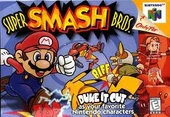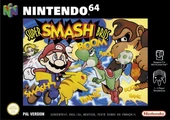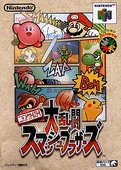- For the article about the series, please see "Super Smash Bros. (series)".
- For the other games see Super Smash Bros. Melee, Super Smash Bros. Brawl, and Super Smash Bros. for Nintendo 3DS and Wii U.
Super Smash Bros. (ニンテンドウオールスター! 大乱闘スマッシュブラザーズ, Nintendo All-Star! Great Fray Smash Brothers) often known as SSB, Smash 64, SSB64, and Super Smash Bros. 64, is a fighting game featuring Nintendo's "all-stars" as playable characters, and the first game of the Super Smash Bros. game series. It has four sequels: Super Smash Bros. Melee, Super Smash Bros. Brawl, Super Smash Bros. for Nintendo 3DS, and Super Smash Bros. for Wii U.
It was released in Japan on January 21, 1999, in North America on April 26, 1999, and in Europe on November 19, 1999. It is playable on Nintendo 64 and the iQue Player and was made available on the Wii's Virtual Console on January 20, 2009 in Japan, June 12, 2009 in Europe, and December 21, 2009 in North America.
Intro
Gameplay
The Super Smash Bros. series is a dramatic departure from other fighting games, such as Street Fighter. Instead of winning by depleting an opponent's life bar, Smash Bros. players seek to knock opposing characters off the stage, KOing them. Characters do not have "health bars" in Super Smash Bros.; they can take an unlimited amount of damage, however, each hit adds to the character's damage percentage. This percentage starts at 0%, but can exceed 100% and caps at 999%, and the higher the damage percentage, the farther an attack will launch an opponent, and the easier it will be to knock them off of the stage. Being knocked too far above, beside, or even under the stage will KO a character. If knocked off, a character may attempt to get back onto the stage by jumping or using various "recovery" moves before they reach the stage's boundaries. Some characters have different recovery moves, while others have better jumps. Some characters are heavier, making them harder to knock off the stage, and making it harder for them to get back onto the stage, while others are lighter, making it easier for them to get knocked away, as well as easier for them to get back.
Each character possesses distinctive and unique moves, and various items which can appear during fights. These items can be melee or long-ranged weapons, throw-able items, power-ups, items that lower a character's damage percentage, and more. Items appear randomly out of thin air, but the player can adjust how often the items will appear, if at all. Some items are references to past Nintendo games, like the Star Rod or the Bob-Omb, while others were specifically made for Super Smash Bros. Poke Balls are an item, and when thrown, a random Pokemon will appear and attempt to attack all of the players except for the one who threw the Poke Ball.
Most stages have a theme relating to a Nintendo franchise or a specific Nintendo game, and are interactive to the player. Although the stages are rendered in three dimensions, characters in Super Smash Bros. can only move on a two-dimensional plane. Some stages also feature random hazards that can help or harm players.
Super Smash Bros.'s play controls are greatly simplified in comparison to other fighting games. While traditional fighting games require the player to memorize button-input combinations (sometimes lengthy and complicated, and often specific to a character), Super Smash Bros. features an easy-to-learn control scheme: A for stanadard attacks and B for special attacks, and the control stick to move. Characters are not limited to constantly facing their opponent, but may run around freely. Smash Bros. also implements blocking and dodging mechanics, as well as jumps and double jumps. Grabbing and throwing other characters is also possible. Combining these many ways to play allows different players to make the game as simple or complex as they like.
Single Player
Although the player can choose from five difficulty levels, the game's single-player mode always follows the same series of opponents. This game mode is called Classic Mode in sequels. The player will choose one unlocked character, and battle against a series of characters in a specific order, attempting to defeat them with only a limited amount of lives. If the player loses all of their lives (or runs out of time), they have the option to continue at the cost of a considerable sum of their overall points. Selecting yes cuts their score in half and restarts the battle. Selecting no or not selecting within a ten second countdown will result in a Game Over.
The "Break the Targets" minigame as well as the "Board the Platforms" minigame are two of the remaining single-player games. The objective of the minigames is to break each target or board each platform, respectively. The goal must be achieved without falling off each character-specific stage. The last one is the "Training Mode" section, where the player can choose any of the available characters and the opponent, as well as any stage. When started, a menu can be brought up to gain almost any control, such as slowed game speed, spawning any item, and telling the opponent what to do.
Multiplayer
Up to four people can play in multiplayer mode, which has specific rules predetermined by the players. Stock and timed matches are two of the multiplayer modes of play. This gives each player a certain amount of lives or a selected time limit, before beginning the match. A winner is declared once time runs out, or all but one player are KO'ed.
Characters
There are twelve playable characters in Super Smash Bros., eight are available from the start, while four are unlockable.
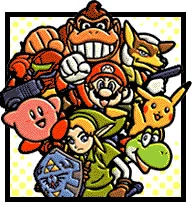
Official artwork of the default cast of Super Smash Bros.
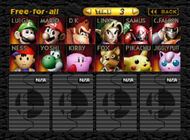
The character-selection screen of Super Smash Bros. (all characters unlocked).
Playable Characters
| Starter characters | |||
|---|---|---|---|
 Mario |
 Donkey Kong |
 Link |
 Samus |
 Yoshi |
 Kirby |
File:FoxSSB.png Fox |
 Pikachu |
| Unlockable characters | |||
 Luigi |
 Captain Falcon |
 Ness |
 Jigglypuff |
Non-playable characters
Stages
There are a total of nine stages, eight starter stages and one unlockable stage.
Playable Stages
| Stages | ||||
|---|---|---|---|---|
 Peach's Castle |
 Congo Jungle |
 Hyrule Castle |
 Planet Zebes |
 Mushroom Kingdom |
 Yoshi's Island |
 Dream Land |
 Sector Z |
 Saffron City |
|
Shown in bold, Mushroom Kingdom is the only unlockable stage in Super Smash Bros.
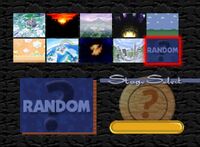
All nine playable stages in Super Smash Bros.
1P Game-only stages
Battlefield
Final Destination
Break the Targets
Board the Platforms
 Metal Mario's Stage
Metal Mario's StageRace to the Finish
Non-playable stages
Beta Dream Land 1
Beta Dream Land 2
Tutorial Stage
Items
Modes
1P Mode
Vs Mode
Tournament play
Unlike Super Smash Bros. Melee, Super Smash Bros. never had a large professional competitive scene, but interest in Super Smash Bros. has been renewed in recent years with the popularity of Super Smash Bros. Melee and Super Smash Bros. Brawl. Players can play Super Smash Bros. online through Kaillera using the Project64k emulator. However, there have been more and more tournaments of Super Smash Bros. recently due to an influx of new players. Most Super Smash Bros. tournaments are paired up with Melee or long events and most (offline) Super Smash Bros. tournaments are located in California, Central Canada, or New Jersey.
Online Play
Although Super Smash Bros. does not feature online play, emulators have the ability to do so. Project64k and Mupen64k are the most used emulators of playing online.
Gallery
Trailers

Super Smash Bros Commercial (N64)

Japanese Super Smash Bros. commercial
Trivia
- It was revealed in an interview with Nintendo's president, Satoru Iwata, that Masahiro Sakurai had intended for Final Smashes to be included in the original Super Smash Bros. He claims that he has proof in the form of recorded voices for when characters used their Final Smash. Hacking into the debug menu of the game, Ness's and Captain Falcon's voice clips for final smashes. But there also exist voice clips for Pikachu, Kirby, and Fox that might have been intended for final smashes as well. The idea, however, was never actually implemented until Brawl.
- Super Smash Bros.. was originally going to be a game named "Dragon King: The Fighting Game" for the Nintendo 64, and only featured placeholder characters. According to the wife of Masahiro Sakurai, Michiko Sakurai, the "in-house" nickname for Dragon King was "Pepsi Man."
- The starting eight characters are placed in the order of when they first appeared in their respective titles on the character selection screen, starting with the oldest, Mario and Donkey Kong, and leading to the most recent, Pikachu.
- When a character is chosen, they perform a brief animation in their player's display box below the character-select array. This is the only game in the series to have this feature.
- In the credits, Charles Martinet, the voice of Mario and Luigi, was misspelled as "Charles Martinee".
- In Super Smash Bros. Melee and Super Smash Bros. Brawl, the characters are trophies that have been brought to life, as demonstrated in their intro sequences and continue screens. This is not the case in Super Smash Bros., in which the characters are instead toys that have been brought to life by Master Hand, and the stages are dioramas.
- The Japanese Version lacks the "Congratulations" screen when you complete 1 player mode.
- The Japanese Version also has completely different sound effects for the hitting of the characters, which are much more realistic like those in Super Smash Bros. Melee and Super Smash Bros. Brawl and other arcade fighting games. This was probably a change done to make the game's sound effects more exaggerated and less realistic to be consistent with the cartoony violence and unrealistic environments/characters the game consisted of. Some speculate, however, that this was actually done for censorship reasons.
- The narrator also says "Fox" in a different tone than the Western version, and he says "Battle Royal" instead of "Free-for-all". In the Western versions, the re-recorded voices have a slightly different echo effect than the Japanese original.
- In the European version of the game, when set to the German Language, the German announcer does not say "Captain Falcon" or "Team Battle" in German.
- Some items (excluding battering items and containers) and all Pokémon are actually 2D sprites.
- It's absolutely impossible (without hacking) to clear all the eight digits on the counter that tells how many points the player has earned in 1P Mode.
- This is the only game in the series to receive a rating of E for everyone. Its sequels Super Smash Bros. Melee and Super Smash Bros. Brawl are both rated T for teen, while Super Smash Bros. for Nintendo 3DS/Wii U is rated E10+.
- This is the only game to exclusively feature Nintendo's heroes. Future installments included playable villains (Bowser, Ganondorf, etc.).
- The playable characters are all veterans that return in future Super Smash Bros. installments.
- The Mario and Pokémon universe are the only universes to have more than one playable character in this game. The Yoshi and F-Zero universes have only one playable character in all iterations of Super smash Bros.
- In the Japanese version, Mario and Luigi have slightly larger heads than in any other version.
- Samus is the only female playable character. Nine characters are male, including: Mario, Donkey Kong, Link, Yoshi, Kirby, Fox, Luigi, Captain Falcon and Ness. Pikachu and Jigglypuff have not been confirmed to be male or female.
- This game actually allows the player to fight characters that have not been unlocked yet.
- The playable characters in the original Super Smash Bros. are all starter characters in Super Smash Bros. for Wii U. Ness and Jigglypuff are unlockable characters in Super Smash Bros. for Nintendo 3DS.
- Super Smash Bros. is the only game to show all the unlockable characters in the intro, being Luigi, Captain Falcon, Ness, and Jigglypuff.
- There was supposed to have a Racing Mini Game, but it was scrapped.
- Super Smash Bros. was meant for a Christmas release in December 1998, but was pushed to 1999 for unknown reasons. As the final build of the Japanese version of the game was dated 12/11/1998. (Source: The Cutting Room Floor and SourceGaming).
- In the intro video the Pokémon Trainer that is walking by Pikachu is possibly was Ash Ketchum from the Pokémon anime series. The Trainer's shoes closely matches of Ash's shoes from the original series.
External Links
- Wikipedia's Super Smash Bros. article
- Official Super Smash Bros. Japanese website
- Official Super Smash Bros. English website (archive)
| |||||



















